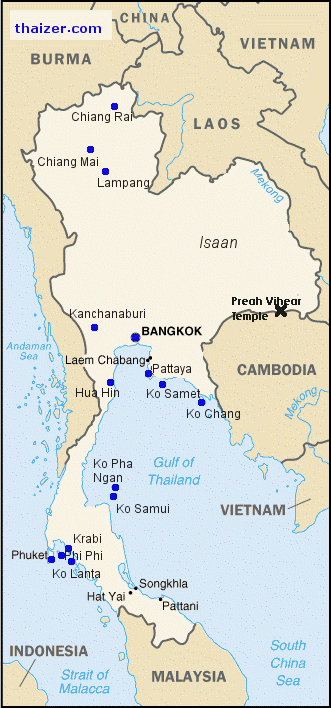 The Khmer ruins of the Preah Vihear Temple (also known as Khao Phra Viharn) are located on top of a cliff on the Thai-Cambodian border approximately 220 kilometres to the south-east of Surin. Construction of the temple is believed to have taken place over a 300-year-period beginning in the ninth-century. The temple was dedicated to the Hindu god Shiva and was an important site which served as a place of pilgrimage for Hindus and a retreat for Hindu priests.
The Khmer ruins of the Preah Vihear Temple (also known as Khao Phra Viharn) are located on top of a cliff on the Thai-Cambodian border approximately 220 kilometres to the south-east of Surin. Construction of the temple is believed to have taken place over a 300-year-period beginning in the ninth-century. The temple was dedicated to the Hindu god Shiva and was an important site which served as a place of pilgrimage for Hindus and a retreat for Hindu priests.
The central sanctuary of Preah Vihear sits on Cambodian soil, but the most convenient form of access is from the Thai side of the border via a road and the start of a staircase which is located within the Thai national park of Khao Phra Viharn. Because of the terrain, access from the Cambodian side of the border is very difficult and most tourists enter the temple from the Thai side of the border. This means that visitors from the Thai side have to pay a fee to Thai authorities to access the national park and another fee to the Cambodian authorities to access the ruins themselves.
The temple has been at the centre of a land dispute that has been going on since 1904 when the border was drawn up between what was then Siam and French Indochina. The issue has never gone away and has flared up again at numerous points throughout the last one hundred years. In 1962, the International Court of Justice ruled that the temple belongs to Cambodia but the surrounding land remains in dispute. In 1975, the Khmer Rouge took control of the temple and as a consequence land mines were laid in the area. The immediate grounds around the temple have now been de-mined but there are marked sections of land in the vicinity which remain off-limits to visitors. Because of the ongoing dispute between Thailand and Cambodia, the temple has been closed at various stages as tension between the two neighbours has risen. This tension flared again in July 2008 when Preah Vihear Temple was awarded UNESCO World Heritage status and with it the prospect of a significant boost in tourist money to the area. It also re-ignited nationalist sentiment on both sides of the border and has raised the prospect of a military dispute between Cambodia and Thailand.